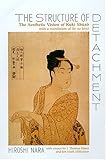The Structure of Detachment : The Aesthetic Vision of Kuki Shuzo / ed. by Jon Mark Mikkelsen, J. Thomas Rimer, Hiroshi Nara.
Material type: TextPublisher: Honolulu : University of Hawaii Press, [2004]Copyright date: ©2004Description: 1 online resource (200 p.) : 59 illusContent type:
TextPublisher: Honolulu : University of Hawaii Press, [2004]Copyright date: ©2004Description: 1 online resource (200 p.) : 59 illusContent type: - 9780824827359
- 9780824865054
- 100
- online - DeGruyter
- Issued also in print.
| Item type | Current library | Call number | URL | Status | Notes | Barcode | |
|---|---|---|---|---|---|---|---|
 eBook
eBook
|
Biblioteca "Angelicum" Pont. Univ. S.Tommaso d'Aquino Nuvola online | online - DeGruyter (Browse shelf(Opens below)) | Online access | Not for loan (Accesso limitato) | Accesso per gli utenti autorizzati / Access for authorized users | (dgr)9780824865054 |
Frontmatter -- Contents -- Acknowledgments -- Introduction -- PART I: translation of Iki no kõzõ -- Translator's Preface -- The Structure of Iki -- PART II :Essays -- Capturing the Shudders and Palpitations: Kuki's Quest for a Philosophy of Life -- Literary Stances :The Structure of Iki -- Reading Kuki Shūzō's The Structure of Iki in the Shadow of L'affaire Heidegger -- Kuki Shūzō Chronology -- Contributors -- Translation Index -- Essay Index
restricted access online access with authorization star
http://purl.org/coar/access_right/c_16ec
Published in 1930, when Japan was struggling to define and assert its national and cultural identity, The Structure of Iki (Iki no kôzô) re-introduced the Japanese to a sophisticated tradition of urbane and spirited stylishness (iki) that was forged in the Edo period. Upon his return from Europe, Kuki Shûzô (1888-1941) made use of the new theoretical frameworks based on Western Continental methodology to redefine the significance of iki in Japanese society and culture. By applying Heidegger's hermeneutics to this cultural phenomenon, he attempted to recast traditional understanding in the context of Western aesthetic theory and reestablish the centrality of a purely Japanese sense of "taste."The three critical essays that accompany this new translation of The Structure of Iki look at various aspects of Kuki, his work, and the historical context that influenced his thinking. Hiroshi Nara first traces Kuki's interest in a philosophy of life through his exposure to Husserl, Heidegger, and Bergson. In the second essay, J. Thomas Rimer compels readers to reexamine The Structure of Iki as a work in the celebrated tradition of zuihitsu (stream-of-consciousness writings) and takes into account French literary influences on Kuki. The philosopher's controversial link with Heidegger is explored by Jon Mark Mikkelsen in the final essay.
Issued also in print.
Mode of access: Internet via World Wide Web.
In English.
Description based on online resource; title from PDF title page (publisher's Web site, viewed 02. Mrz 2022)


